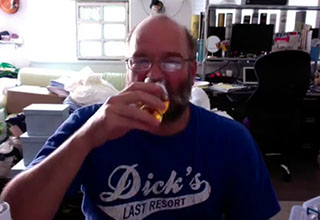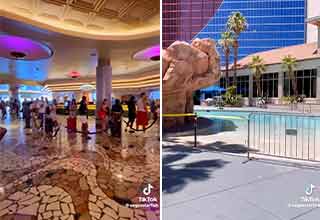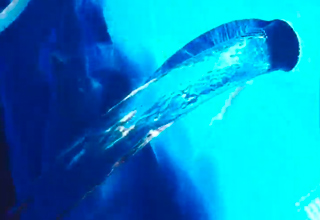
What the hell does Ron English have to do with eBaum's World?
Ron is a visionary street artist who played an integral role in elevating what was commonly dismissed as a simple form of vandalism, into the juggernaut of popular culture that it is today.
eBaum's World took the most significant advancement in human communication since the written word, and used it to flood the world with videos of nut shots and kittens singing death metal.
Soooo… maybe not the most obvious of connections, but it's there dammit! It just took the twisted vision of TOTT GLOBAL to see it, and bring them together. Recently eBaum’s World got the chance to tag along with Ron, his wife and kids on an All-American road trip -- with a twist. The end result is called The Detroit Project.
Using billboards and brick walls, museums and movies, Ron English has spent the past several decades subverting corporate identities and cultural icons for his own twisted artistic vision. He’s a genuinely funny guy with a dry and biting wit, and he uses striking depictions of familiar imagery to communicate his own personal brand of social commentary that he calls “POPaganda”. It’s a testament to the quality of his work -- and the universality of his message -- that he has been equally successful in galleries and on the streets, around the world.
Ron lives in a two-story colonial-style house, with a manicured lawn in front and lush forest in back. It looks pretty much like any other house in the upscale, upstate suburb of Beacon, N.Y.
Inside is another story. Ron’s huge paintings of superheroes drinking beer cover the walls. Floor-to-ceiling shelves display hundreds if not thousands of the hilariously satirical vinyl collectibles that Ron is known for.
But like Ron’s art, the outrageous is always juxtaposed with the conventional. Ron’s kids come down for breakfast wearing Abercrombie and Fitch. His wife, Tarssa, cooks up scrambled eggs in their tasteful granite and stainless eat-in kitchen, and they all sit down to eat breakfast together ... with a life-sized Mouse Mask Murphy statue watching from the corner.
It’s like Martha Stewart meets Kid Robot.
After breakfast, cars are packed for the road trip. Large items first: tubs of wheat paste and brushes, camera equipment and suitcases. The remaining space is jammed with poster tubes of pre-printed and sliced graphics, cans of spray paint, and, last but not least, people.
The English family of four planned the trip to Detroit for a number of reasons. The Motor City is a haven for artistic types: Cheap rents and economic incentives have made Detroit an up-and-coming destination for creative young talents. The sprawl of abandoned buildings and urban decay provide a perfect canvas for graffiti. The combination of opportunity and audience have made the place a hotbed of global street art. Also, Ron’s wife Tarssa grew up in Detroit, making it a sort of perfect storm of graffiti vacation and family homecoming.
Ron’s process is all about going heavy on preparation up front, then improvising on site. Since “The Detroit Area” was about as specific as the discussion got in terms of picking exact locations to hit, once everyone arrived it was a matter of exploring the city, interacting with locals, and waiting for inspiration to strike.
Once Ron finds a spot he likes, he lets the place dictate the piece. This is where all his preparation pays off; the mountain of rolled-up graphics gives him plenty of flexibility in terms of how he wants to play with the environment.
On site, the artistic process is a family affair. Son Mars stencils while daughter Zephyr snaps pics for the POPaganda blog, and Tarssa keeps everything running smoothly. Ron is the director, energetically explaining and actualizing his vision for the spot.
He’s not remotely worried about getting his hands dirty; other than the most acrobatic of image placements, he’s right in the thick of things at all times. It’s a well-oiled machine, and when a member of Detroit’s Finest pulls up to the scene, the efficiency of the English family system is on full display. Ron calmly deflects, reflects and half answers all questions posed to him, like some demented lawyer. Tarssa interjects with the voice of reason, taking calm, assertive control of the situation.
Caught up in the swirl of dialogue, the cop has no chance ...
Following this brush with the law, Ron decides to move the operation someplace where he won’t be disturbed. He finds it in the old Packard automotive plant, which covers 3.5 million square feet on a 40 acre-parcel of land. When the plant opened in 1903, it was considered the pinnacle of modern engineering and manufacturing. It closed its doors in 1958, essentially abandoned to the elements. All that’s left is a hulking shell with burned-out rooms, collapsed walls and vegetation slowly retaking the landscape. Wandering the halls is like maneuvering through a minefield of broken glass and debris, accompanied with the constant threat of weakened floors collapsing, and four-story falls.
But despite the apocalyptic state of the landscape, there are signs of life. Various inhabitants of the plant (human and otherwise) scurry at the sight of their unexpected visitors. and bristle with annoyance at the intrusion into their home.
And there’s art. Beautiful art. The abandoned plant presents a nearly endless expanse of brick walls begging to make a statement. It’s like it was destined to be a sort of museum, the Louvre of street art.
With such a palette, artists have come from around the world to add their work, including Ron English. eBaum’s World got lucky, and got to witness his contribution to the cause.
-
-
eBaum's Picks
-
Advertisement




